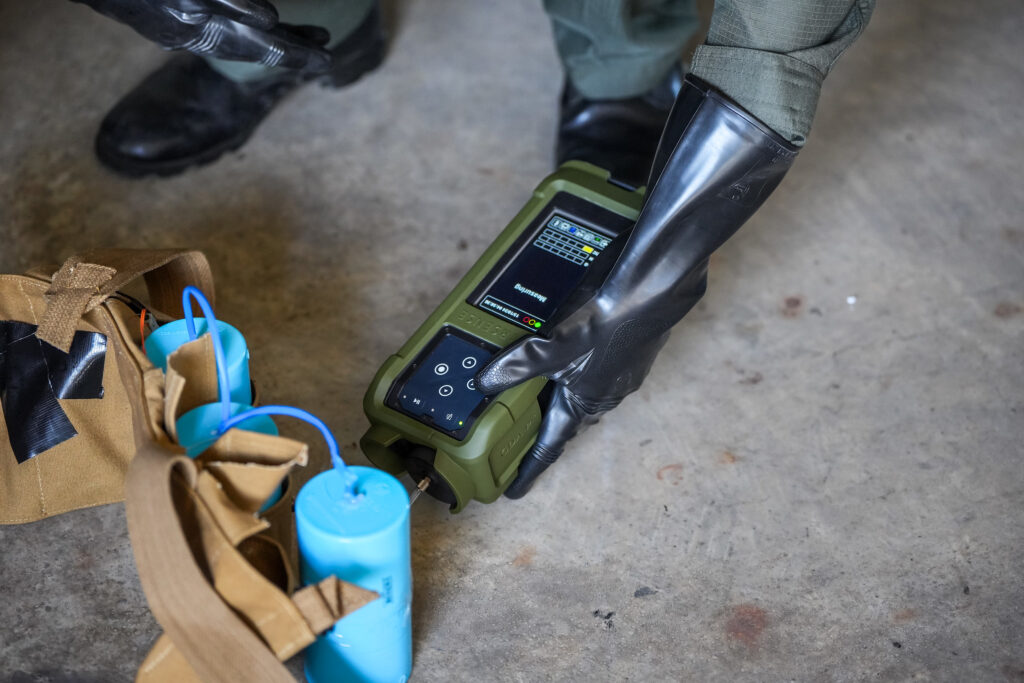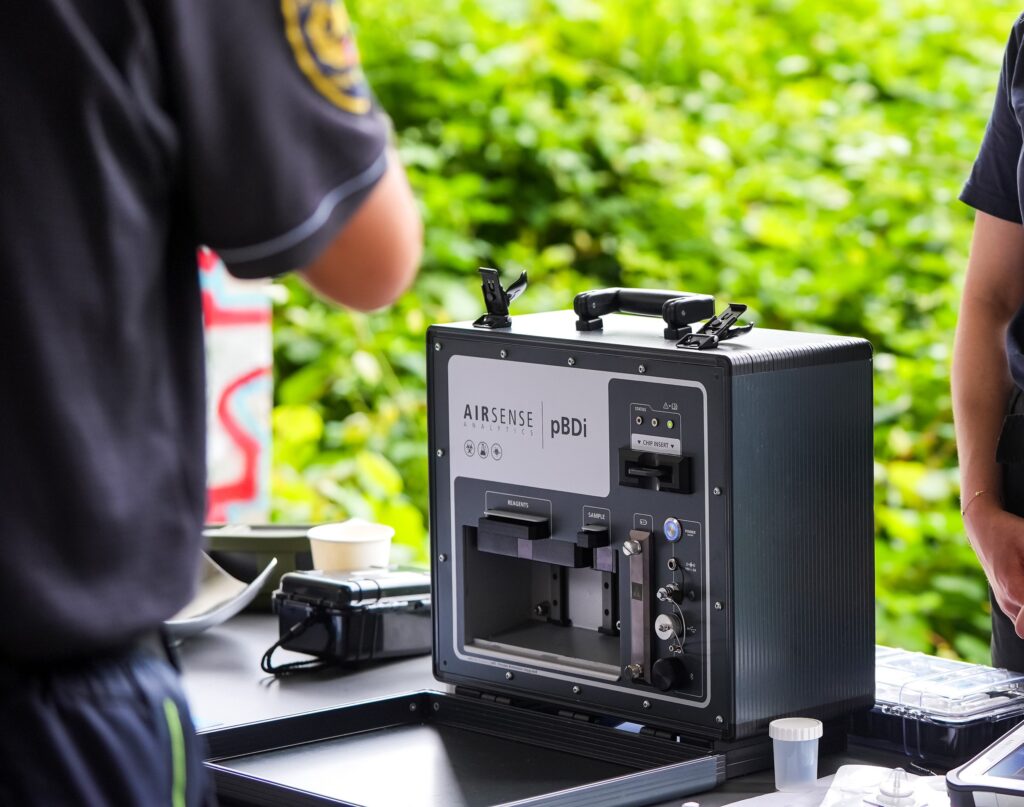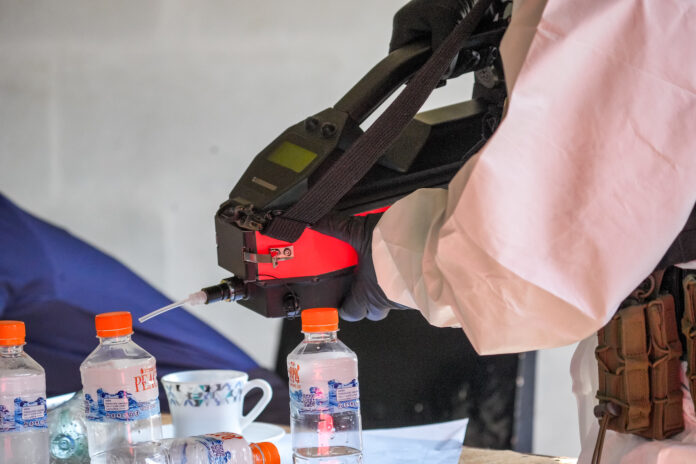By AIRSENSE Analytics
AIRSENSE Analytics discusses the most prominent techniques behind field-capable detectors that balance sensitivity and specificity.
CBRNE incidents continue to pose significant concerns for governments, industries, and local communities around the world. Whether triggered by industrial accidents or deliberately orchestrated for malicious purposes, these events require fast and accurate detection capabilities to minimize harm. Over the past decades, portable devices have revolutionized how first responders, military personnel, law enforcement teams, and public health officials approach threat assessment. By combining multiple sensor types in compact, user-friendly formats, modern detection systems can address a wide range of hazards, from toxic industrial chemicals, to chemical warfare agents, and even biological pathogens or toxins.
A key driver behind these developments is the shift toward real-time situational awareness. In practice, this means that responders no longer must rely exclusively on laboratory-based analyses that may take hours or days to deliver definitive results. Instead, they can deploy portable platforms that immediately indicate whether dangerous substances are present, guiding decisions on evacuation, decontamination, or specialized containment measures. Such tools not only enhance operational efficiency but also help protect personnel and the broader public. For the detection of chemical and biological warfare agents, AIRSENSE provides reliable solutions to support real-time decision-making and enhance safety in critical situations.
Designing a robust field-capable detector calls for a careful balance between sensitivity – detecting very low concentrations of dangerous substances – and specificity – distinguishing genuine threats from benign substances. A device with insufficient sensitivity might fail to detect trace amounts of highly lethal agents, while a system lacking specificity could trigger constant false alarms, undermining responders’ confidence. Advances in electronics, sensor miniaturization, and analytical algorithms have made it possible to pack multiple detection principles into a single instrument. These multi-sensor arrays cross-reference data from different sensing technologies, reducing the likelihood of both missed detections and nuisance alarms.

Ion Mobility Spectrometry
Among the most prominent techniques in chemical threat detection is ion mobility spectrometry (IMS). IMS separates ionized molecules in the gas phase based on how quickly they travel under an electric field, creating distinct “mobility signatures” that can be matched against a reference library. However, many IMS-based devices operate in environments where moisture, temperature fluctuations, or the presence of sticky analytes can degrade accuracy. A heated membrane is therefore crucial in preventing or even optimizing signal quality. To date, AIRSENSE is understood to be the only provider that integrates IMS, a heated membrane, and additional sensor technologies into a single device, ensuring stability in a variety of operating conditions and enabling reliable detection of hazardous chemicals even under challenging circumstances.
Although IMS is particularly effective in detecting many nerve agents and numerous volatile organic compounds, it does not uniformly capture every possible chemical threat. Detecting certain other agents can be more challenging as these compounds occasionally exhibit different analytical characteristics and are not differentiable from other substances with the same mobility signatures solely using IMS. Additional sensor modalities – such as photoionization detectors, electrochemical detectors, or metal oxide sensors – can provide complementary coverage.
In practice, these extra sensors help either confirm IMS readings for high-priority chemicals or expand the range of substances detected. For instance, specialized electrochemical sensors may be employed to validate hydrogen cyanide indications via IMS, while photoionization detectors are well-suited to measure volatile organic compounds. By consolidating multiple detection methods into a single unit, overall detection accuracy can be improved, and false alarm rates can be reduced. This results in a unit that provides a multi-sensor approach covering a vast spectrum of chemical threats. Built-in algorithms then process the signals from all sensors concurrently, cross-referencing real-time data against an extensive chemical library. Devices like gas detector arrays utilize such multi-sensor integration to enhance detection accuracy and broaden the range of identifiable chemical substances.
Ease of Use
Beyond the sensors themselves, ease of use is integral to these technologies. Field operations can be chaotic: operators may wear heavy protective suits, have limited visibility, and work under severe time pressure. Integrated vehicle solutions address these realities by transforming vehicles into operational platforms, equipped with detection capabilities that function with mounted handheld units. These devices can be removed at any time and again used as handheld detectors. Such approaches not only accelerate the detection and identification process but also streamline communication with command centers, enabling more dynamic and immediate responses.
Although chemical threats often dominate the headlines, biological hazards can be equally, or if not more disruptive if allowed to spread undetected. From anthrax spores to pathogens, a single release event can have far-reaching consequences. Immunoassay-based devices adapted for field use, such as modified enzyme-linked immunosorbent assay systems, have become popular thanks to their efficiency. These portable kits, which may run analyses in as little as 15 to 30 minutes, support both civilian and military operations where laboratory access is restricted or time-critical.
One example is a portable biodetector (pBDi) integrating precise fluidic control with automated data processing and enabling the parallel detection of multiple biothreat agents. By automating most sample handling steps, such systems minimize human error and reduce the logistical burden on teams deployed in the field. Whether for outbreak investigations or suspected bioterror incidents, rapid on-site screening can be indispensable in mitigating further harm.

Training, Maintenance, Connectivity
Even the most advanced sensors can yield unreliable data if improperly used or poorly maintained. Comprehensive training programs often include classroom instruction and hands-on exercises. In field simulations, trainees learn how to perform sampling efficiently, interpret results under time constraints, and apply follow-up protocols, whether it be it evacuation, decontamination, or medical intervention.
On the maintenance side, devices typically require periodic checks for sensor drift and calibration. Some maintenance can be done by the end user, e.g. changing the filters. Some models feature an internal self-check function that prompts the operator to run calibration procedures or replace consumables. Ongoing research aims to refine sensor performance while further simplifying the user experience. There is also growing interest in miniaturized sensor arrays, which could be integrated into unmanned ground vehicles or aerial drones to scout high-risk zones before human teams enter.
As network connectivity expands, modern detection systems are already capable of automatically streaming live data to regional or national control centers, providing a real-time map of potential threats. Such connectivity would be particularly valuable during large-scale events or multi-site incidents, where multiple teams must coordinate seamlessly.
From gas detector arrays and heated-membrane IMS systems that excel at detecting chemical warfare agents, to immunoassay-based biodetectors such as pBDi built for biological hazards, today’s portable detection technologies represent a remarkable fusion of science and engineering. Their widespread adoption underscores how crucial it is for organizations to rapidly identify threats at the point of incidence. While no single device can address every conceivable hazard, deploying a complementary suite of chemical and biological sensors gives decision-makers the most comprehensive situational picture possible.
Moreover, the transition from purely lab-focused approaches to field-ready solutions aligns with the realities of modern security operations. Whether scanning cargo shipments in a major seaport, monitoring a large public event, responding to an industrial chemical release, or assessing potential CBRN incidents, portable detection offers on-the-spot analysis that can avert widespread harm. The ability to rapidly identify hazardous substances in dynamic environments ensures a faster and more coordinated response, reducing risks to both responders and the general public.

Crucial Safeguards for the Future
Ultimately, the effectiveness of any detection tool depends on consistent maintenance, rigorous operator training, and seamless integration into emergency response protocols. CBRN threats continue to evolve, demanding continuous advancements in detection technologies and operational strategies. By refining established methods such as IMS and immunoassays, and integrating emerging innovations, safety and security professionals can significantly enhance their ability to detect, assess, and mitigate hazardous incidents. Portable detection systems are not only a key asset in today’s security landscape but also a crucial safeguard for the future.
AIRSENSE Analytics GmbH was founded on April 15, 1996, by Dipl.-Ing. Wolf Münchmeyer and Dr.-Ing. Andreas Walte in Schwerin, Germany. Both studied at the Technical University of Hamburg-Harburg. The idea of manufacturing an electronic nose for laboratory purposes arose during their student days and led the two to found a company. After 28 years, the electronic nose is still an integral part of the product range. Today AIRSENSE is one of the worldwide recognized suppliers of safety and security equipment.





